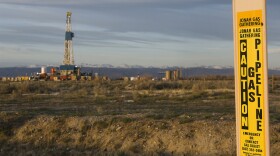Wastewater from fracked wells that produce gas and oil in Pennsylvania and West Virginia is coming to Ohio.
Julie Grant, a reporter who has been researching this issue, says Ohio has become a go-to place for the nation's fracking waste disposal. Grant reports on environmental issues in Ohio and Pennsylvania for the program The Allegheny Front.
"Energy companies point to the geology. They say the layers of underground rock that are better for wastewater storage are easier to access in Ohio, than in Pennsylvania’s hilly Appalachian basin," Grant says.
Pennsylvania is one of the top natural gas producers in the nation, but it’s more difficult to permit a disposal well there. Grant says there are only a few waste disposal wells in the whole state.
Ohio also has industry-friendly regulations. Oil and gas companies need permits to dispose of fracking waste underground.
In other states around the region, including Michigan and Pennsylvania, the Environmental Protection Agency has authority over those permits -- and the process can take a year or more. But in Ohio, the same permits can be issued in a matter of months. That's because Ohio has primacy over injection wells, so the state, not the federal government, issues the permits and the process is often faster.
Grant writes in her story for The Allegheny Front:
Randy Roberts is an attorney for Houston-based Stallion Oilfield, which owns three injection wells in Ohio’s Portage County. Roberts knows some people don’t like it, but he says Ohio’s uniform state zoning regulations are also attractive. “I’m not trying to be difficult here, but I would like to think that Ohio has made a pitch to be relatively benign. They do not make regulations just for the sense (sic) of making regulations, but they want us to do our jobs," Roberts says. "They come out here and inspect us and then they leave us alone if they find we’re doing our jobs.”
What's in the wastewater?
0000017b-35d9-df5e-a97b-35fd9ebe0000
When energy companies use a method of drilling for natural gas called horizontal hydraulic fracturing, they use millions of gallons of water, along with sand and a proprietary mix of chemicals.
"It's all under high pressure. They break up the underground rock, and release the oil and gas. But one result of that process is a lot of wastewater. Now, much of that waste is put into trucks, and brought to what are called 'injection wells' " says Grant.
The wastewater is filtered to remove debris and any radioactive material before it is sent back underground. The solid waste is sent to landfills and other places, and the remaining water is pumped into the injection well.
According to a 2012 ProPublica report, there are more than 680,000 underground waste and injection wells nationwide, more than 150,000 of which shoot industrial fluids thousands of feet below the surface.
Michigan also takes fracking waste from other states. Here, the Department of Environmental Quality regulates what goes into landfills and disposal wells. Companies need permits from both the EPA and the MDEQ to drill and operate an injection well. Cities and villages also have zoning authority over oil and gas disposal wells in Michigan. (Townships and counties, however, do not.)
‘No choice about it’
People who live near these waste sites in Ohio are expressing concern. Gwen Fisher is a retired professor who lives in Portage County. Her husband sits on the local township board, which is in charge of most zoning decisions.
“He can spend hours discussing with his fellow board members whether or not somebody can build a fence, or keep chickens, or put up a sign.” she says. “And then the next day, their neighbor could have leased land and they could have a 3- to 8-acre well pad pretty close to their house, or a pipeline, and have no choice about it.”
Fisher says the industrial trucks go rumbling through, and they're changing the landscape of her rural community. Portage County has the most fracking waste disposal wells in the state of Ohio.
Studies have linked seismic tremors in the Youngstown, Ohio area to the disposal of fracking wastewater. The EPA has yet to release a report on whether injection wells increase seismic danger in fracking disposal areas.
A number of Ohio communities are trying to get some control over the oil and gas operations in addition to the waste wells.
“The most watched case here is a city that’s sued the state, saying the Ohio Constitution gives them what’s called 'home rule authority' over all zoning, including oil and gas wells,” says Grant.
A decision is expected from the Ohio Supreme Court any time now.








